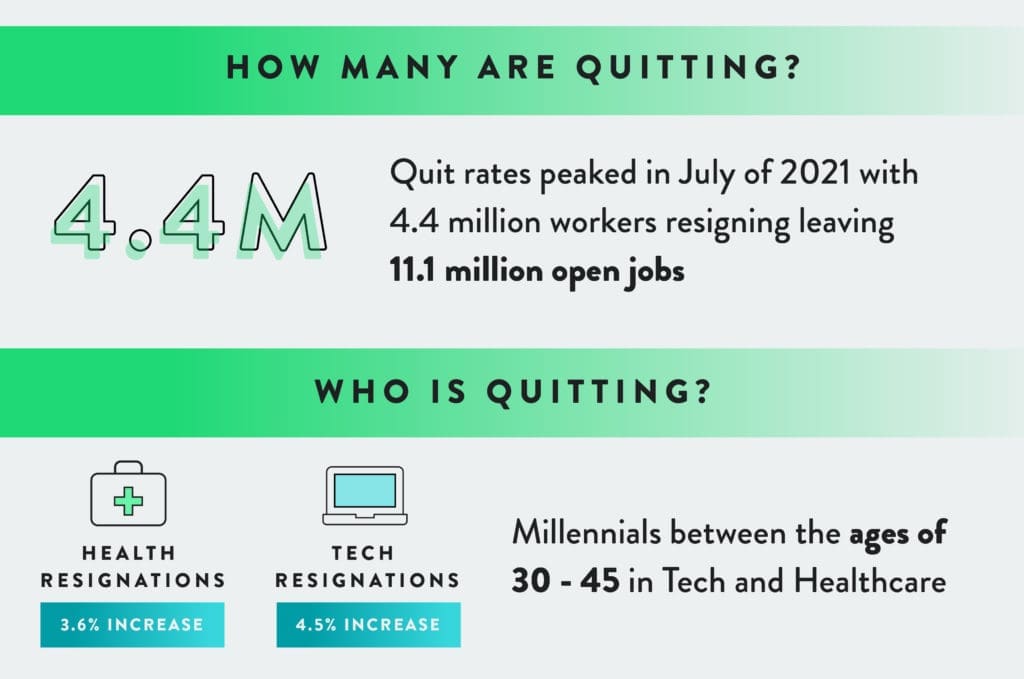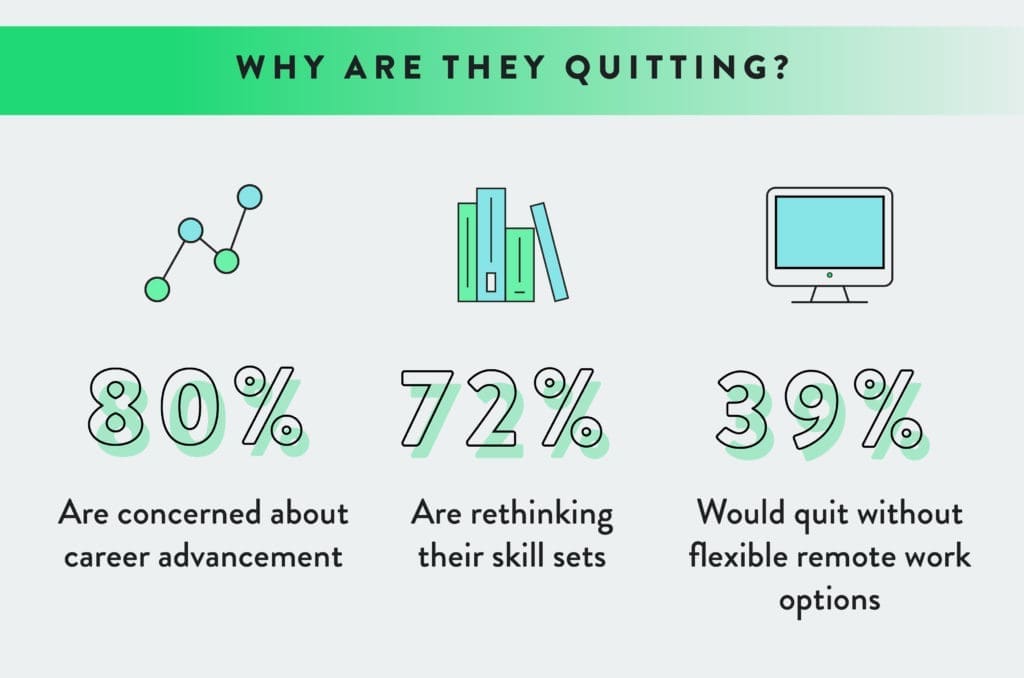How The Great Resignation Has Changed Staffing Forever

If you’ve been online for more than ten minutes in the past year you’ve likely seen “The Great Resignation” referenced in news, videos, podcasts, print media, and even in our 2022 Salary Guide that spotlights the most current industry trends.
But why’s it getting so much coverage and what does it actually mean? Not only that, if 2021 was the year of the Great Resignation – what will 2022 bring?
In short, The Great Resignation is the term that was coined to describe the historical quit rate happening within the job market as a result of the COVID-19 pandemic.
All of a sudden employers were faced with having to shift to provide for remote workers, shut down in-person offices, and find ways to maintain employee engagement, and as a result, millions of jobs still remain unfilled.
Some journalists have begun referring to this job market trend as the “Forever Resignation” — as evidence may suggest these resignation levels are here to stay.
With the Bureau of Labor Statistics reporting that 4.5 million Americans quit their job in March of 2022, employers must quickly adapt and understand this new landscape where employees have more power and flexibility than ever before.
How are employers handling the Great Resignation now?
Many companies are in the position of having to decide whether or not to remain remote or start asking employees to return back to the office.
But how, in this unprecedented time, where there is no rulebook for “How To Keep People Employed During a Pandemic” can employers pivot and adapt to keep up with the demands of the IT, Tech, Digital Marketing, and Creative talent they need to keep the lights on?
But before you hit the panic button, there is good news.
While resignations are at an all-time high, it doesn’t necessarily have to mean doom and gloom for employers.
With so much changing, there are endless opportunities to refresh and reshuffle your staff and make the internal organizational changes that have been a long time coming anyway.
Before we can talk solutions though, we have to understand what we’re working with first…
How many people are driving the Great Resignation?
Per the US Bureau of Labor Statistics, 4.4 million American workers left their positions in July 2021 and resignation rates have remained steady since, with a record-breaking 11.1 million available jobs at the end of October.

What groups are quitting the most?
While we may hear a lot about the labor shortage for service industry jobs like food service, according to the Harvard Business Review, there are some key trends beginning to surface when it comes to the demographics of those quitting their jobs and driving the need for workers in specific industries.
Namely millennial, mid-career employees in the tech and healthcare industries. We’ll spare you all the percentage breakdowns but suffice to say, there’s never been a time in history where the need for IT, Tech, Digital Marketing, and Creative talent has been so great.
Why are so many people quitting their jobs?
It should come as no surprise that the ability to work remotely from the comfort of home without long commutes, expensive lunches out, and added child care costs have forever changed the collective labor market’s mindset.
Now that more and more studies are coming out saying that working from home actually leads to better productivity, employers can no longer claim risk to the bottom line if workers aren’t in the office.
When polled, employees made it very clear what they’re most concerned about when it comes to deciding whether or not to resign:
- 80% of employees are concerned about their career advancement
- 72% are thinking of learning a new skill set and trying something new altogether
- 39% would quit their current jobs if flexible remote work options are not offered

What can employers do to avoid more resignations?
So what does all of this mean for employers? How can they keep up with a workforce that’s not content to sit in an office and who want to feel like they’re working for more than just a paycheck?
While focusing on employee retention is a great place to start to combat resignation rates, there are other things you can do short term to attract the key employees and top-tier talent you need now.
Employers need to offer remote work options
Since it’s been well established over the past 2 years that business performance doesn’t suffer having people work from home, the average American worker is going to want a remote work option.
That, combined with the fact that history shows labor shortages favor workers and give them leverage in the job market, is just further proof that employers need to adapt.
Real-talk: It may be hard to accept but it’s time to let go of the notion of having a completely in-person workforce ever again and embrace moving into the new digital world.
Companies need more competitive salaries and benefits
While the Covid-19 pandemic was the biggest challenge we’ve had to endure as a nation in a generation, it also opened the door for millions of people to have “pandemic epiphanies” to reassess their priorities and what they want from their work and life.
And their assessment? Better emphasis on mental health, a defined career path with room for upward mobility, higher salaries, and more overall healthy employee experiences.
Tools like our Salary Guide can help guide you in keeping up with industry trends, shifts that happened during the pandemic, and the annual salary you should expect to pay the top-tier candidates you’re looking to hire in IT, Tech, Digital Marketing, and Creative roles.
Hiring managers need expert staffing help
More and more employers are turning to staffing agencies to help them fill positions and for good reason.
National staffing agencies like Mondo work with a pool of thousands of the most experienced and desirable candidates that can be hard to find as a hiring manager learning how to navigate the changing tides of the job market.
Mondo is committed to matching employers with the right people by staying on the cutting edge of hiring trends, using our proprietary process to place candidates in record time (3-5 days for contract positions and 5-8 days for full-time positions), AND by working closely with employers to help them ease their transition into the new world to make offers that attract the best talent.
Final thoughts on the Great Resignation
The current job market gives employees the opportunity and leverage they need to be patient and wait for the right job and while certain experts predict that the pandemic trend will level out eventually and The Great Resignation will be over by 2023, the American workforce and industry employment standards will never be the same.
Not to mention, some studies estimate that about 25% of workers plan to quit their jobs once the pandemic is no longer a threat.
So our advice for employers? Get with the times and work with experts to make the changes necessary to not get left behind.
Now is the moment to embrace these exciting times and show what you can really do as an organization and how agile, adaptable and attractive you can be to candidates as they decide where to go next.
Find great talent when you partner with Mondo
Looking to hire? Contact us to get started:
Mondo Matches Great Talent With Great Companies
With an expansive, connected network of the top IT, Tech, Creative, and Digital Marketing professionals and a proprietary process, Mondo can match you with the hard-to-find, specialized talent you need.
- Contact Mondo today for all your hiring needs
- Download our 2022 Salary Guide for detailed salary breakdowns for roles & jobs across the technology, creative & digital marketing industries



